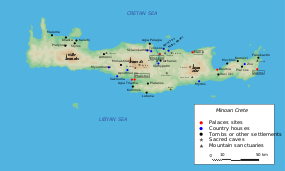Phaestus
| Φαιστός | |

View of Phaistos
|
|

Map of Minoan Crete
|
|
| Alternate name | Phaestus |
|---|---|
| Location | Municipality of Faistos, Regional Unit of Heraklion, region of Crete in Greece |
| Region | The eastern point of a ridge overlooking Messara Plain to the east |
| Coordinates | 35°03′05″N 24°48′49″E / 35.05139°N 24.81361°ECoordinates: 35°03′05″N 24°48′49″E / 35.05139°N 24.81361°E |
| Type | Palace complex and surrounding city |
| Part of | The state ruled from Knosses under a monarchy symbolized by "King Minos" |
| Area | 8,400 m2 (90,000 sq ft) for the palace. The city covered the hill and a few km into the valley below. |
| History | |
| Builder | Unknown |
| Material | Trimmed blocks of limestone and alabaster, mud-brick, rubble, wood |
| Founded | The first settlement dates to the Late Neolithic starting about 3000 BC. The first palace dates to about 1850 BC |
| Periods | Late Neolithic to Late Bronze Age. The first palace was built at the start of Middle Minoan |
| Cultures | Minoan |
| Satellite of | The kingdom centered at Knossos |
| Associated with | In the Bronze Age, people of unknown ethnicity now called Minoans |
| Site notes | |
| Excavation dates | 1874, Federico Halbherr alone 1900–1904, 1950–1971, Italian School of Archaeology at Athens Since 2007 the Phaistos Project has been conducting a survey and exchange of information about the Phaistos region |
| Archaeologists | 1900–1904, Federico Halbherr and Luigi Pernier 1950–1972, Doro Levi |
| Condition | Current interventions are tamped soil, stone walkways, hand rails, lightly roofed areas. More are planned in the interests of preservation and access. |
| Management | 23rd Ephorate of Prehistoric and Classical Antiquitites; Italian School of Archaeology at Athens; University of Salerno, Department of Cultural Heritage Sciences |
| Public access | Yes |
| Website | "Phaistos". Odysseus. Hellenic Ministry of Culture and Tourism. 2007. |
| Phaistos Project: Italo-Greek archaeological surveys in the city and territory of Phaistos | |
Phaistos (Greek: Φαιστός, pronounced [feˈstos]; Ancient Greek: Φαιστός, pronounced [pʰai̯stós]), also transliterated as Phaestos, Festos and Latin Phaestus, currently refers to a Bronze Age archaeological site at modern Phaistos, a municipality in south central Crete. Ancient Phaistos was located about 5.6 km (3.5 mi) east of the Mediterranean Sea and 62 km south of Heraklio, the second largest city of Minoan Crete. The name, Phaistos, survives from ancient Greek references to a city in Crete of that name, shown to be, in fact, at or near the current ruins.
The name is substantiated by the coins of the classical city. They display motifs such as Europa sitting on a bull, Talos with wings, Heracles without beard and being crowned, or Zeus in a form of a naked youth sitting on a tree. On either the obverse or the reverse the name of the city, or its abbreviation, is inscribed, such as ΦΑΙΣ or ΦΑΙΣΤΙ, for Phaistos or Phaistios ("Phaistian" adjective) written either right-to-left or left-to-right. These few dozen coins were acquired by collectors from uncontrolled contexts. They give no information on the location of Phaistos.
Phaistos was located by Thomas Abel Brimage Spratt, commander of the Spitfire, a paddle steamer, in the Mediterranean Survey of 1853, which surveyed the topography, settlements and monuments of Crete. Spratt followed the directions of Strabo, who said:
...
Wikipedia
